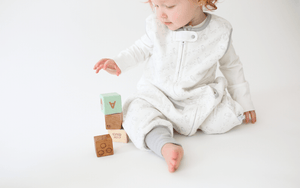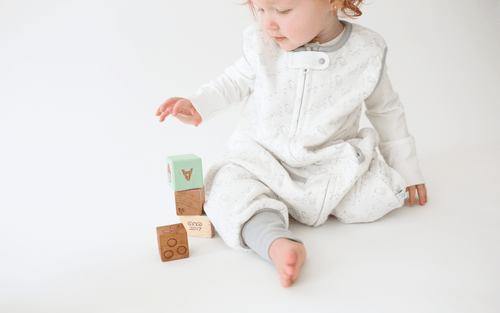6 Effective ways to manage your toddler’s tantrums at bedtime

Toddler bedtime tantrums got you down? These six toddler sleep training tips can help make bedtime a breeze.
Toddlers are some of my favourite humans. Waddling around, discovering how their limbs move, how to express themselves, creating imaginary worlds and inviting us big people along for the ride.
They are snuggly. They are sweet. They are wide eyed to all that surrounds them.
Yet anyone who has spent time with these tiny people knows that it’s not all unicorns and rainbows (a shout out to my 3 year old). Toddlers love to explore limits. Test boundaries. Strive for autonomy. It’s how they gain an understanding of the world and their place in it.
And one of their favourite times to put their newfound agency to the test is bedtime. And for good reason. Going from waking to sleeping is the biggest transition in any day. And toddlers are notoriously shabby at transitions.

Gone are the days when you could read a story, tuck your little in, give them a kiss and leave the room. Suddenly they have turned into a master strategist, trying to think of anything and everything to avoid going to sleep.
A glass of water. Another hug. What will happen if I call mama’s name one more time? Or throw my lovey on the floor only to cry out for someone to retrieve it? They might be missing me downstairs. I should let them know that I’m still here.
To add fuel to the fire, thanks to extending wake windows and an age-dependent shift in the circadian system, toddlers are capable of staying awake for longer periods of time. This inevitably pushes bedtime later and later, to the point that you may be thinking “is it negligent if I fall asleep before my 2 year old?” or “why won’t my toddler sleep?”.
Limit testing + long wake windows + a circadian phase shift = a perfect storm for bedtime battles.
Though the frustration and fatigue surrounding toddler tantrums at bedtime are real, this phase is completely developmentally normal. But, how can you help stop toddler tantrums before bed?
Relevant Reads:
- 5 Things You Must Know to Help Your Baby Sleep
- Why is my toddler not going to sleep
- All about sleep regressions

Six Toddler Sleep Training tips in managing toddler tantrums at bedtime
These are tips you can use to bring the calm, cool, and collected back to bedtime.
And if your toddler is going through sleep regressions, which often comes at around 2 years old, following these tips will also help you bring back the normal.
1. Run inventory on the sleep environment
There’s a lot of debate over whether it’s necessary to have a completely dark or a completely quiet sleep environment. Isn’t it better that kids learn to sleep in variable conditions? Won’t different environments bring about more flexibility down the road?
On this one, it’s best to err on the side of rigidity when tantrums at bedtime arise. Remove any possibility that the sleep environment is working against you. Hang those blackout blinds and turn up that sound machine or your favorite toddler sleep aid that will help your toddler sleep. Remove any stimulating distractions.
When sleep is restored and bedtime a breeze, you can experiment with switching thing up should you choose.
2. Make sure the body and brain are ready to sleep.
Just like brushing teeth and bathing, sleep hygiene is crucial for taking care of the sleep system.
- Set the same wake time each morning. Follow with consistent nap and bedtimes. The body thrives on these daily rhythms.
- Bask in lots of natural light (and dark!). The brain responds to the difference between the lightest light and the darkest dark that it sees in the day. Nothing beats the sun when it comes to light, so take a walk or play at the playground to get a healthy boost of light exposure, especially in the early part of the day. Then turn the lights down dim in the evening to mimic the setting sun (use lights with a soft orange or red glow during the bedtime routine). And draw those blackout blinds when it’s time for lights out.
- Plan an earlier dinner. The digestive system and the sleep system can work against each other and make sleep difficult to come by. If you’re concerned about a picked through, half eaten meal, and a correspondingly hungry toddler, offer a light, healthy bedtime snack (try avocado on toast or plain yogurt with berries).
- Limit the use of screens in the hour or two before bed. Blue light may not be as bright as the sun, but it’s still bright, which means the brain has a hard time distinguishing whether or not it’s still daytime.
Similar to the sleep environment, it’s best to be rigid with sleep hygiene when experiencing toddler bedtime battles to ensure that the internal system is primed and ready to sleep when the time comes.
3. Note the natural sleep time.
With the capacity to stay awake for longer periods plus a shifted circadian rhythm, it may be that bedtime is simply drifting later than usual. Take tabs for 3 or 4 nights noting what time your toddler actually falls asleep.
You may be attempting bedtime at 7pm, yet they are not drifting off until 8:30pm. If this is the case, try shifting “bedtime” closer to the natural sleep time at first. Go for 8pm instead so that your little one is good and ready to sleep when you are asking them to.
When bedtime becomes easier, you can always drift back to an earlier bedtime in small increments (try 15 mins earlier every 2 to 3 days) to reset to an earlier circadian rhythm.This is a great strategy to your toddler’s sleep training and will help make future bedtimes become more natural.
4. Allow some activity in your toddler’s bedtime routine.
Part of becoming a toddler involves the desire to do more for themselves. They seek agency and a sense of control. Try using cue cards of the pre-sleep routine sequence (bath, jammies, teeth, story, song etc) and let your little one flip through as you go. Let them choose their pjs and story. Let them push the button on a toddler clock to signal the day is done. Or check off a step on their bedtime routine chart.
These tangible actions help them to feel independence and accomplishment, while also sending a clear message when the routine is done.
5. Set firm limits.
Know before the routine begins how many stories you will read. How many songs you will sing. How many hugs/cuddles will follow. Communicate these clearly and stick to your guns. Anticipate any requests and offer them up before your little one asks.
Hold the no and don’t fear the battle that may result.
Tell yourself that the fastest route to sleep is not the goal. Helping your toddler get to a point where their body can take over and initiate sleep with ease and confidence is the goal. Clearly communicated boundaries lets your toddler know what’s expected and in turn helps them feel safe and ready to sleep.
6. Celebrate desired behaviours.
Toddlers are thirsty for your attention and approval. If battles have become a norm, make it very clear when they’ve done something you’re looking for. Did they climb into bed on their own? Lay their head down on the pillow? Let you leave the room momentarily while staying put? Praise the behaviour.
Tell them what a big kid they are becoming. How proud you are of them. That you’re coming back for one more big hug. Things not going quite as planned? Give little attention to undesired behaviours. Repeat the expectations, lay them down again, and keep calm. In their mind, attention is attention. Don’t leave them guessing over what it is you’re wanting from them.
Toddler bedtime tantrums can feel like a marathon with the finish line far from sight. Structures, routines, and clear, consistent communication are your tickets to cross.






















